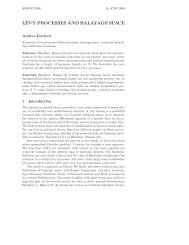Degenerate parabolic stochastic partial differential equations
Degenerate parabolic stochastic partial differential equations
Degenerate parabolic stochastic partial differential equations
Create successful ePaper yourself
Turn your PDF publications into a flip-book with our unique Google optimized e-Paper software.
4296 M. Hofmanová / Stochastic Processes and their Applications 123 (2013) 4294–4336<br />
In Section 5, the existence of a kinetic solution is shown for general initial data. In the Appendix,<br />
we formulate and prove an auxiliary result concerning densely defined martingales.<br />
2. Notation and the main result<br />
We now give the precise assumptions on each of the terms appearing in Eq. (1). We work on<br />
a finite-time interval [0, T ], T > 0, and consider periodic boundary conditions: x ∈ T N where<br />
T N is the N-dimensional torus. The flux function<br />
B = (B 1 , . . . , B N ) : R −→ R N<br />
is supposed to be of class C 1 with a polynomial growth of its derivative, which is denoted by<br />
b = (b 1 , . . . , b N ). The diffusion matrix<br />
A = (A i j ) N i, j=1 : TN −→ R N×N<br />
is of class C ∞ , symmetric and positive semidefinite. Its square-root matrix, which is also<br />
symmetric and positive semidefinite, is denoted by σ .<br />
Regarding the <strong>stochastic</strong> term, let (Ω, F , (F t ) t≥0 , P) be a <strong>stochastic</strong> basis with a complete,<br />
right-continuous filtration. Let P denote the predictable σ -algebra on Ω × [0, T ] associated<br />
to (F t ) t≥0 . The initial datum may be random in general, i.e. F 0 -measurable, and we assume<br />
u 0 ∈ L p (Ω; L p (T N )) for all p ∈ [1, ∞). The process W is a cylindrical Wiener process:<br />
W (t) = k≥1 β k(t)e k with (β k ) k≥1 being mutually independent real-valued standard Wiener<br />
processes relative to (F t ) t≥0 and (e k ) k≥1 a complete orthonormal system in a separable Hilbert<br />
space U. In this setting, we can assume, without loss of generality, that the σ -algebra F is<br />
countably generated and (F t ) t≥0 is the filtration generated by the Wiener process and the initial<br />
condition. For each z ∈ L 2 (T N ) we consider a mapping Φ(z) : U → L 2 (T N ) defined by<br />
Φ(z)e k = g k (·, z(·)). In particular, we suppose that g k ∈ C(T N ×R) and the following conditions<br />
G 2 (x, ξ) = gk (x, ξ) 2 ≤ L 1 + |ξ| 2 ,<br />
k≥1<br />
(2)<br />
<br />
g k (x, ξ) − g k (y, ζ ) 2 ≤ L |x − y| 2 + |ξ − ζ |h(|ξ − ζ |) , (3)<br />
k≥1<br />
are fulfilled for every x, y ∈ T N , ξ, ζ ∈ R, where h is a continuous nondecreasing function on<br />
R + satisfying, for some α > 0,<br />
h(δ) ≤ Cδ α , δ < 1. (4)<br />
The conditions imposed on Φ, particularly assumption (2), imply that<br />
Φ : L 2 (T N ) −→ L 2 (U; L 2 (T N )),<br />
where L 2 (U; L 2 (T N )) denotes the collection of Hilbert–Schmidt operators from U to L 2 (T N ).<br />
Thus, given a predictable process u ∈ L 2 (Ω; L 2 (0, T ; L 2 (T N ))), the <strong>stochastic</strong> integral t →<br />
t<br />
0 Φ(u)dW is a well defined process taking values in L2 (T N ) (see [8] for detailed construction).<br />
Finally, define the auxiliary space U 0 ⊃ U via<br />
U 0 =<br />
<br />
v = α k e k ; <br />
k≥1 k≥1<br />
α 2 k<br />
k 2 < ∞ <br />
,



